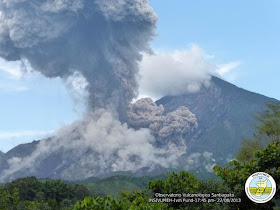The Instituto Nacional de Sismologia, Vulcanologia, Meteorologia, e Hidrologia in Guatemala reported lava being extruded in the crater of Santa María, a volcano in the southwest of the country, on Tuesday 22 August 2013, followed at 5.45 pm local time (11.45 pm GMT) by the collapse of the southeast part of the crater rim, resulting in a pyroclastic flow (avalanche of hot rock, ash and gas), which reached the base of the volcano on the south and southeastern sides. This was accompanied by bombs (incandescent rocks or lava) being thrown up to 500 m from the crater and a 4 km high ash column. On 23 August a smaller eruption generated a 600 m ash column, and ashfalls were reported in Palajunoj. At 8.15 am local time (1.45 pm GMT) on 24 August an explosion in the crater was heard 20 km away, accompanied by further collapse of the southeast portion of the crater rim and more pyroclastic flow. This was followed by a similar explosion at 10.15 pm local time, again accompanied by a partial rim collapse and pyroclastic flows, and a 4 km high ash column that drifted to the southwest. This was followed by several more explosions and pyroclastic flows on 25 August, and an explosive eruption at 3.25 am local time on 27 August that produced a 1.3 km ash column and a pyroclastic flow to the southwest.
A pyroclastic flow on Santa María on 22 August 2013. Instituto Nacional de Sismologia, Vulcanologia, Meteorologia, e Hidrologia.
The volcanoes of Guatemala, and Central America in general, are fed by the subduction of the Cocos Plate beneath the Caribbean Plate along the Middle American Trench, which runs roughly parallel to the southwest coast of the isthmus. As the Cocos Plate sinks into the Earth, it passes under Central America, which lies on the western margin of the Caribbean Plate. As this happens it is heated by the friction and the heat of the planet's interior, causing the sinking plate to partially melt. Some of the melted material then rises through the overlying Caribbean Plate as magma, fueling the volcanoes of Central America.
See also Magnitude 6.2 Earthquake beneath Guatemala, Eruption on Mount Pacaya and Earthquake off the coast of Guatemala.
Follow Sciency Thoughts on Facebook.

